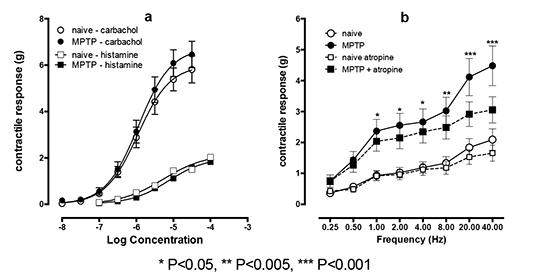Print version
Search Pub Med
The spontaneous and neurogenic contractile responses of the isolated bladder smooth muscle are markedly enhanced in MPTP treated common marmoset (Callithrix jacchus) Dysfunction of the lower urinary tract, such as urinary urgency and incontinence, characterised as bladder hyperreflexia, is a common non-motor feature of Parkinson’s disease (PD) (1). Previously, it was shown that common marmosets rendered parkinsonian with 1-methyl-4-phenyl-1,2,3,6-tetrahydropyridine (MPTP) also displayed bladder hyperreflexia (2) but the cause of this hyperreflexia has been attributed to central effects. To date no study has investigated whether there are any alterations in the parkinsonian bladder at the level of smooth muscle in primates. Here we compared the contractile responses of the detrusor strips from normal, drug naïve and animals that were previously MPTP treated (0.2mg/kg/day, s.c. for 5 consecutive days).
Fig. 1: Contractile responses common marmoset detrusor strips in response to agonist (a) and EFS (b) Figure 1 The bladder was removed from pentobarbital sodium euthanized normal (n=7) and MPTP (n=6) animals and immediately placed in oxygenated ice-cooled Krebs solution (4°C). Longitudinally oriented strips, 10 mm long and 3 mm in thickness were suspended in 25 ml organ baths containing oxygenated Krebs solution at 37°C, straddled between a pair of platinum stimulating electrodes under 1.0 g tension. Tension changes were recorded using an isometric transducer connected to a digital chart recorder. After measuring the amplitude of spontaneous contractions, response to a range of concentrations of carbachol (0.01-30 µM) and histamine (0.1–100µM) was assessed. The tissues were then contracted by electrical field stimulation (EFS) using trains of 20 pulses at 0.2 ms pulse-width delivered at frequencies ranging from 0.25 Hz to 40 Hz in the presence or in the absence of 1µM atropine. All EFS-evoked contractions were abolished by 2µM tetrodotoxin. Data is shown as mean ± sem of contractile response in grams and the differences between tissues obtained from the normal and MPTP animals were compared using two-way ANOVA. The amplitude of spontaneous contraction was significantly greater in the MPTP group (MPTP: 0.55 ± 0.4 g; naïve: 0.34 ± 0.08 g; P<0.05; unpaired t-test). However, no difference in carbachol or histamine evoked contraction was detected between the strips from the two animal groups (fig 1a), suggesting that MPTP treatment did neither sensitise the smooth muscle nor did it affect the cholinergic receptors. Interestingly, the strips from MPTP group produced significantly greater contractions to EFS compared to the MPTP-untreated tissues in an atropine insensitive manner (fig1b). This suggests that bladder hyperreflexivity has a local as well as a central origin. The enhancement of contractile response following MPTP treatment might be due to loss of an inhibitory transmitter, brought about by adaptive change to the detrusor neuro-architecture in response to the alterations in the central input following PD. 1- Albanese A, Jenner P, Marsden CD et al., (1988) Neurosci. Lett. 87, 46-50 2- Chaudhury KR and Schapira, AH (2009) Lancet Neurrol. 8, 464-474
|


